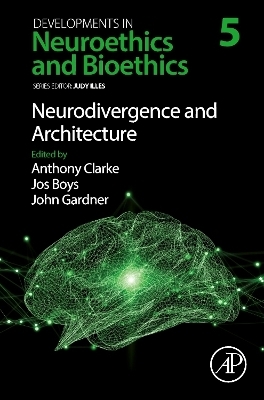
Neurodivergence and Architecture
Academic Press Inc (Verlag)
978-0-12-824562-0 (ISBN)
Professor in the Department of Neurology and Research Chair in Neuroethics for the University of British Columbia, Dr. Illes is also Co-founder and Executive Committee Member for the Neuroethics Society. She is one of the leading voices in neuroethics today and has published extensively in this realm (Editor: Handbook of Neuroethics/2011, Neuroethics: Defining the Issues in Theory, Practice, and Policy/2005). She also serves as Chair for the International Brain Research Organization (IBRO), Committee Chair for Society for Neuroscience, Editorial Board Member for Journal of Ethics in Mental Health, and Senior Editorial Advisor for American Journal of Bioethics: Neuroscience. Anthony Clarke is a practicing architect, educator, and current PhD candidate at Monash University, Australia. Anthony's research focuses on the relationship between architecture and care, seeking to rearticulate practice through innovative and reflexive methodologies. Anthony established BLOXAS in 2010. BLOXAS is a practice for empathic and experimental architecture. BLOXAS' approach is led by research, experimentation, curiosity and care. These elements are inherent in our philosophy, and drive our interrogative and empathetic response. Specialists from a variety of disciplines contribute to our curative understanding of individual and collective behaviour, sensory perception, physiology and phenomenology. We investigate how people affect – and are at the effect of – our designs. Dr Jos Boys trained in architecture and has worked as a journalist, teacher, researcher and design practitioner. She has taught architecture and interior design (in both the design studio and through history and theory) for many years across many universities, both in the UK and abroad. Her research focuses on the social aspects of architecture and interior design. This is underpinned by a design and artistic practice centred on working with community and disadvantaged groups. She is especially interested in how design intersects with gender, class, race and disability; and in finding creative forms of collaboration with non-designers. Jos has an MA in photography and likes to use a variety of media and approaches to open up productive ‘spaces’ between designers educators, students, artists and the wider public. John’s research is situated at the intersection of medical sociology and science and technology studies (STS), and it examines the interplay between biomedicine, individuals and society, particularly in regard to cutting-edge biomedical innovation. His research has focused predominately on two, much-championed areas of biomedicine: the development and implementation of deep brain stimulation and other neurotechnologies, and; the attempts by stakeholders in several countries to create a ‘health and wealth’ generating Regenerative Medicine industry.
Section 1 Frameworks 1. The neuroethics of architecture Judy Illes and Camille Y. Huang 2. Science and Technology Studies (STS) and the neuroethics of architecture John Gardner 3. Disability studies, neurodivergence and architecture Jos Boys 4. Autoethnographic reflections on architectural design for neurodivergence Anthony Clarke
Section 2 Advocacy 5. Cultural commentary: Being autistic together Jim Sinclair 6. Self-made design notes for an autistic's office Marie K. Harder 7. Equalities design: Toward post-normative equity Natasha M. Trotman 8. Dialogic Drawing Yeoryia Manolopoulou
Section 3 Practices 10. Not all surfaces catch the light at the same time Sonia Boue 11. Admission: The mycelia of neuroqueer touch in architectures of madness J.T. Eisenhauer Richardson 12. Creating autistic space in ability-inclusive sensory theatre Molly Mattaini 13. The virtual dementia experience Tanya Petrovich 14. Designing with neurodiverse children and adults: learning a different lesson with every engagement Sarah Wigglesworth and Clare Bond 15. Relax and resist: Reflections on the Touretteshero Relaxed Venue methodology William Renel and Jessica Thom 16. Chronic pain and chronic illness: A crash course in cloudspotting Raquel Meseguer Zafe
| Erscheinungsdatum | 10.10.2022 |
|---|---|
| Reihe/Serie | Developments in Neuroethics and Bioethics |
| Mitarbeit |
Herausgeber (Serie): Judy Illes |
| Verlagsort | San Diego |
| Sprache | englisch |
| Maße | 152 x 229 mm |
| Gewicht | 770 g |
| Themenwelt | Medizin / Pharmazie ► Medizinische Fachgebiete ► Neurologie |
| Naturwissenschaften ► Biologie ► Humanbiologie | |
| Naturwissenschaften ► Biologie ► Zoologie | |
| Technik ► Architektur | |
| ISBN-10 | 0-12-824562-X / 012824562X |
| ISBN-13 | 978-0-12-824562-0 / 9780128245620 |
| Zustand | Neuware |
| Informationen gemäß Produktsicherheitsverordnung (GPSR) | |
| Haben Sie eine Frage zum Produkt? |
aus dem Bereich


